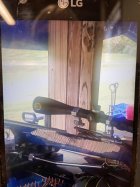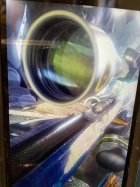I have read that measured muzzle velocity will be different with different people shooting the same rifle and ammo. If this is true, it seems it would prove that some of the energy used to push the bullet forward is pushing the rifle rearward while the bullet is still in the barrel.
I’m going to try to smoke some pilots out of the eaves again, but that’s proving hard to do

.
This theory or principle you describe would have to work the same way going forward and backward.
Looking at an A-10 Warthog with its big 30mm, we know that the rapid fire chain gun’s recoil is significant and slows the plane dramatically.
The first rounds fired at say 1,000 MpS leave at that speed plus the speed of the plane in that direction, a second or two later in the burst the plane has slowed, but scores of rounds were shot.
Those first rounds, judged from the ground hit harder and travelled faster (factor out that the gun gets closer to the target) than subsequent rounds, say by 10%.
It would not be correct to conclude early rounds penetrating deeper had higher ME or caused more recoil;
the end of the barrel sees them all leave at the same V, but a ground radar near the target trained just 3 inches in front of the barrel is going to report each round going slower than the one before it, (because the plane slows) and both are correct. But, the rounds were charged with exactly the same powder and bullets and were shot from the same barrels, recoiling the same.
The 30’s hit at different speeds because the gun was moving differently, shot to shot. I’d surmise that people can affect the velocity of a bullet on target.
(Some shooters lean forward involuntarily. You see this when the gun doesn’t fire but they expected it to. Some slap the trigger back, either with or without palm wrap, others intentionally start the gun on the arc or line they expect it will need to travel, which is easier on the body. In the tests you reference, we don’t know how much different velocity was).
But just like with the A-10,
they
moving the whole gun slightly differently, but the interplay between the bullet and barrel would result in the same outcome every shot if they were not.
Edit: Also, I think about it this way, if their moving the gun is
not the explanation for different velocity, then they are necessarily somehow affecting the internal pressure inside the barrel. To my thinking, if the bullet is gone, these are the only two ways that velocity can altered at the point that firing occurs, and that second possibility I can’t see happening.
The third possibility is of course the bullet moving the gun itself before exit, if the gun is allowed to move, if this occurs. I saw a video last evening of multiple guns recorded that shot a “squib load” which stuck in the barrel, and of course those guns were put down immediately, as there was now a deadly obstruction should another shot be fired. The point of that video was to warn shooters, but that kind of video may also show whether there is even slight recoil or not occurring pre-exit.
It would be very interesting to see whether an F-Open rifle shot different velocities from a machine rest versus string pull free recoil on the bags, though, and that would certainly be easier than trying to film the bullet’s exit. However, high speed photography does reveal how much gas blow by is occurring and the shock wave size of the ambient barrel air, both which would have the same apparent effect as the recoil we are talking of.
.22 barreled actions are clamped routinely for lot testing, effectively making them a gun of hundreds of pounds that a .22 charge cannot budge. It might be interesting to know what Lapua and Eley would say about whether this increases muzzle velocity.
As an Open shooter, my guess is that you won’t see a difference in velocity but you will in accuracy, for the reason that other movements besides recoil affect accuracy.













